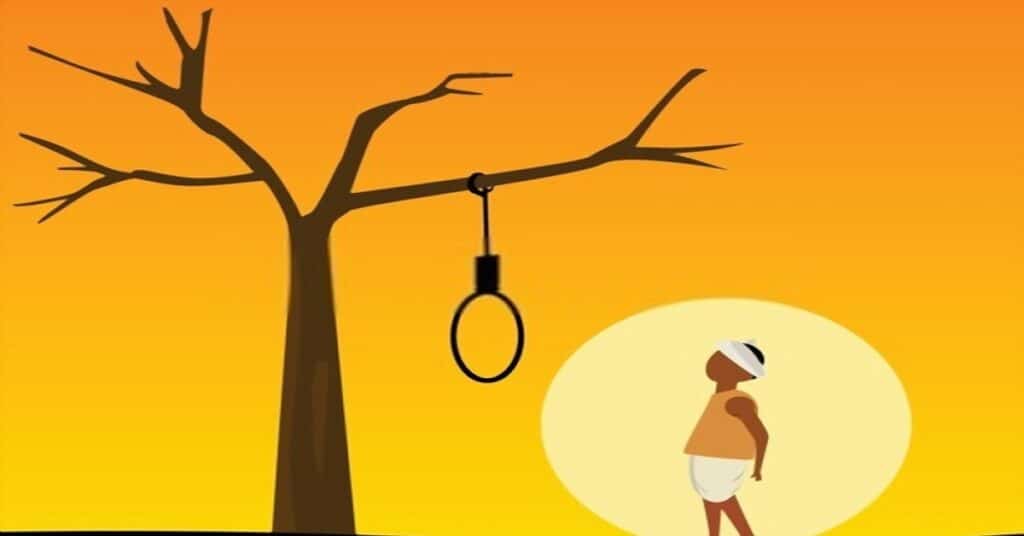
India, known as the agricultural hub of the world, is facing a grave crisis. Farmers in India are committing suicide at an alarming rate. This has been a topic of concern for several years. The reasons behind these suicides are many – from debt traps to crop failures and natural calamities. Let’s dive deeper into the issue of farmer suicides in India and attempt to understand their plight. This essay on farmers’ suicide in India is not just for school or college students but for every citizen.
Essay on Farmers Suicide in India- 100 Words
Farmers’ suicide in India is an alarming issue. This serious issue needs immediate attention and action. The agricultural sector faces multiple challenges, leading to an alarming rise in suicide rates among farmers.
The root causes of farmers’ suicides are complex and interconnected. The causes of the farmers’ suicides include mounting debts, crop failures, unpredictable weather patterns and inadequate irrigation facilities. Market fluctuations also contribute to the farmers’ mental problems.
These challenges create a daunting environment for farmers. These impact their livelihoods and overall well-being.
The farmer crisis has many negative effects. It hurts families emotionally and financially and makes the agricultural situation worse. This leads to problems like not having enough food, economic instability, and social unrest. To solve this crisis, we need a comprehensive plan.
We must focus on farmers’ well-being and fix the problems causing their distress. By making supportive policies, improving infrastructure, and giving farmers power, we can end farmer suicides.
Also Read:
- Village Paragraph
- Essay on Discipline
- I Want to Become a Pilot Essay in English
- Essay on Importance of Fashion
- Essay on Shaheed Udham Singh
Essay on Farmers Suicide in India- 150 Words
Farmers are the backbone of a country’s economy. It is unfortunate that they are facing such dire circumstances. The issue of farmer suicides in India has become a pressing concern over the years. Several factors have contributed to this phenomenon. Some main reasons for the farmer’s suicides are droughts, crop failures, debt burdens, lack of government support and policies favouring large industrial corporations. Indian farmers struggle with debts because of unpredictable weather and low crop yields. This makes them feel depressed. It also affects their mental health.
Sadly, some farmers even take their own lives. The government must act quickly to help them. They can implement policies to reduce farmer distress. For example, they can improve access to credit with lower interest rates. Government can provide subsidies for seeds and fertilizers.
It’s time to appreciate and value the hard work and dedication of our food producers who feed us every day.

Farmers Suicides in India Essay- 200 Words
As per a survey, 58% of the Indian population lives in farming. Agriculture and Farming are considered the backbone of our nation. It’s a harsh reality to know that farmers in India are facing a serious problem – suicide.
In recent years, there has been an alarming increase in the number of farmer suicides. The reasons for this trend are complex and multifaceted. Let’s get into the root causes of farmer suicides and how it affects not only farmers but also their families and communities.
It’s clear that the well-being of farmers is critical to the country’s economy and social stability. However, despite being the backbone of India’s agrarian society, farmers continue to face numerous challenges such as debt, low crop yields due to climate change, and lack of access to modern technology and markets. These issues have pushed many farmers into despair, with suicide rates among agricultural workers increasing dramatically over the past few decades.
While government schemes like loan waivers offer some relief in the short term, they cannot address deeper systemic problems. It’s time for a long-term solution that addresses these root causes by investing in rural infrastructure, developing sustainable farming practices and providing education and training opportunities for farmers. Only then can we hope to create a future where our brave food growers can thrive instead of just survive?
Essay on Farmers Suiciding in India – 300 words
In India, agriculture has been the backbone of the economy for centuries. However, the unfortunate reality is that farmers in India are facing a crisis that is pushing them to take their own lives at an alarming rate. With increasing debt burdens and crop failures due to climate change and other factors, many small-scale farmers are struggling to make ends meet. Let’s explore the root causes of farmer suicides in India and discuss possible solutions to this pressing issue.
Causes of Farmers’ Suicide:
1.Financial burdens and debt: Farmers face mounting debts due to factors such as crop failures, unpredictable weather conditions, and high input costs. The inability to repay loans often leads to immense stress and hopelessness.
2.Crop failure and climate challenges: Indian farmers heavily rely on monsoons for irrigation. Irregular rainfall patterns, droughts, floods, and other climate-related issues disrupt agricultural productivity, trapping farmers in cycles of debt and despair.
3.Limited access to credit and insurance: Many farmers lack access to formal credit and crop insurance, leaving them financially vulnerable and ill-equipped to deal with emergencies.
4.Lack of alternative livelihood opportunities: A significant number of farmers in India have limited options for diversifying their income. Overdependence on agriculture as the sole source of livelihood increases their vulnerability.
Solutions:
1.Strengthening agricultural infrastructure: The government should invest in improving irrigation facilities, modernizing farming techniques, and providing timely access to agricultural inputs to reduce dependency on rainfall and enhance productivity.
2.Financial support and debt relief: Farmers should have easy access to institutional credit at reasonable interest rates. Implementing debt relief programs and loan restructuring initiatives can alleviate the burden of accumulated debts.
3.Crop insurance and risk management: Expanding crop insurance schemes and implementing effective risk management measures can protect farmers from unexpected losses and stabilize their income.
4.Promoting diversified income sources: Encouraging farmers to engage in allied activities like dairy farming, poultry, or horticulture can reduce their dependence on agriculture and provide additional sources of income.
Conclusion: Farmers’ suicide in India is a grave issue that requires immediate attention from policymakers, society, and individuals. By addressing the underlying causes of agrarian distress, providing financial and infrastructural support, and promoting alternative livelihood opportunities, we can work together to improve the lives of farmers and ensure the sustainability of the agricultural sector.

Essay on Farmers Suicide in India for School and College Students- 400+ words
Introduction
India is known for its rich agricultural heritage and has been providing food to the world since time immemorial. However, behind this glory lies a heart-wrenching reality that many farmers in India’s face – suicidal tendencies.
Despite being the backbone of our economy, farmers in India are grappling with severe economic distress leading to drastic steps like taking their own life. The issue of farmer suicides is not new but it continues to be unresolved even today. Let’s explore the history and reasons behind farmer suicides in India.
The following long essay on farmers’ suicide in India for school and college students aims to provide insight into one of the most pressing issues faced by Indian agriculture today.
History of Farmers Suicide in India
The history of farmers’ suicide in India can be traced back to the 1990s when the country adopted a policy of economic liberalization. This policy led to an increased focus on commercial farming and cash crops, which made small-scale agriculture less profitable. Farmers who could not afford modern farming techniques, such as irrigation systems and fertilizers, were particularly affected by this shift.
In addition to this, natural disasters like droughts and floods have also been a major contributing factor to farmer distress. These events often lead to crop failure and financial losses for farmers who are already struggling with debt.
Another significant issue that has contributed towards farmer suicides is the lack of social security measures for rural populations. In many cases, farmers are left without any support or compensation when their crops fail or they fall into debt.
Furthermore, issues related to land ownership disputes and inadequate representation in government policies have also added to the woes of Indian farmers.
It is clear that there are multiple complex factors at play when it comes to understanding why so many farmers in India take their own lives. Understanding these underlying issues will be crucial for developing effective policies aimed at supporting vulnerable farm communities across the country.

Reasons for Farmers Suicide in India
The reasons behind this catastrophic trend are complex. One of the main factors is the lack of irrigation facilities, which leads to droughts and crop failures in many regions across India.
Reliance on Unpredictable Monsoon Rains and Debt Traps- Moreover, farmers have to rely on unpredictable monsoon rains as their primary source of water for crops. This uncertainty often results in debt traps due to borrowing money from private lenders at high-interest rates to fund their farming activities.
Increasing Cost of Inputs and Financial Struggles- Additionally, the increasing cost of inputs such as seeds, fertilizers, pesticides, and labour adds up quickly and makes it difficult for small-scale farmers with limited resources to sustain themselves financially. Coupled with fluctuating market prices for agricultural produce that are not always favourable; farmers find themselves struggling to repay loans leading them towards depression & suicidal tendencies.
Land Degradation and Unsustainable Farming Practices- Another contributing factor could be land degradation caused by unsustainable farming practices like excessive use of chemical fertilizers resulting in soil erosion over time.
Comprehensive Attention from Policymakers- These issues concerning Indian agriculture require comprehensive attention from policymakers who need to implement policies focused on safeguarding farmer livelihoods while simultaneously promoting sustainable agricultural practices through better infrastructure development & more efficient input markets among other strategies – all aimed at reducing farmer suicides across India!
Government Policies on Farmers Suicide in India
The Indian government has taken several steps to address the issue of farmers’ suicide in India. In 2018, the government launched a new program called “Pradhan Mantri Fasal Bima Yojana” (Prime Minister Crop Insurance Scheme) to insure farmers against crop losses due to natural calamities, pests and diseases. This scheme aims to provide financial assistance to farmers in case of any loss or damage caused by unforeseen events.
Another policy initiative is the “National Agriculture Market” (eNAM), which is an electronic platform that connects all agricultural produce markets across India. Through this platform, farmers can sell their products directly to buyers without intermediaries, thereby eliminating middlemen and ensuring fair prices for their produce.
Moreover, the government has also introduced loan waiver schemes for distressed farmers who are unable to pay back loans taken from banks or other institutions. These policies aim at reducing the burden on indebted farmers and providing them with some relief.
However, critics argue that these policies are not enough as they fail to address fundamental issues such as lack of irrigation facilities, poor access to credit and market linkages for small-scale producers. The need for more comprehensive reforms remains crucial if we want long-term solutions that will benefit our struggling farming communities across India.
Impact of Farmers’ Suicide on the Economy of India
The impact of farmers’ suicide on the economy of India is significant and far-reaching. Agriculture is a crucial sector of the Indian economy, providing employment to more than 50% of its population. The increasing rate of farmer suicides in India has not only caused immense emotional distress but also economic instability.
Farmers are the backbone of the agricultural industry, and their untimely deaths have left families struggling financially. The loss of income affects not only their dependents but also results in reduced agricultural productivity, leading to higher food prices and inflation.
Moreover, farmers’ suicides have led to a decrease in investments in agriculture due to uncertainty among investors about future profits. This lack of investment further hampers economic growth through decreased capital formation.
The government’s response to this issue has been inadequate with policies that focus primarily on debt relief and compensation payments instead of addressing the root causes such as low crop yields and lack of access to credit facilities.
Farmer suicides negatively affect both individuals and society as a whole by limiting economic growth potential while exacerbating poverty levels within rural areas. Therefore, it is essential for policymakers at all levels – local or national – to work together towards solutions that address these issues holistically rather than just treating symptoms like debt relief programs alone without considering other factors affecting agriculture production efficiencies such as technological advancements or irrigation systems availability etc.,
Conclusion
The issue of farmers’ suicide in India is a complex problem that needs urgent attention. The reasons for these suicides are multifaceted and deeply rooted in the agricultural sector’s inefficiencies, policies, and practices.
The government must take proactive measures to address this issue by implementing policies that can provide relief and support to struggling farmers. These could include debt relief programs or access to affordable credit facilities.
Moreover, there is an urgent need for increased investment in agriculture research and development so that Indian farmers can adopt sustainable farming practices and improve their yields. Additionally, social protection programs like health insurance schemes or pension plans should be introduced to help ease some of the financial burdens faced by vulnerable families.
It’s time for all stakeholders – government officials, civil society organizations, NGOs – to collaborate actively towards finding long-term solutions for this crisis. By working together effectively we can prevent more tragic loss of life among our hard-working farmers while also ensuring food security across our nation.
FAQs-
1)Why isn’t anyone bothered about the farmer suicides in India?
The issue of farmer suicides in India is indeed a matter of concern, and it has garnered attention from various stakeholders. However, the reasons for the continued prevalence of farmer suicides are complex and multifaceted, making it a challenging problem to address effectively.
There are several reasons why the issue of farmer suicides may not receive as much attention as it deserves:
1.Lack of Awareness: The general public may not be fully aware of the magnitude and severity of the problem. Media coverage and public discourse on farmer suicides often fluctuate, leading to fluctuations in public attention as well.
2.Priority Allocation: Governments and policymakers face numerous pressing issues and limited resources. Sometimes, other urgent matters, such as national security, public health, or economic stability, receive more immediate attention and resources.
3.Fragmented Agricultural Sector: Agriculture in India comprises a vast and diverse landscape, with varying challenges across regions. This fragmentation can make it difficult to develop comprehensive solutions that cater to the unique needs of different farming communities.
4.Complex Causes: Farmer suicides are influenced by a combination of factors, including financial distress, agricultural challenges, social factors, and mental health issues. This complexity makes it challenging to identify and address the root causes effectively.
5.Policy Implementation and Execution: Even when policies and programs are developed to support farmers, issues can arise in their implementation and execution. Delays, corruption, and lack of coordination can hinder the impact of initiatives intended to alleviate farmer distress.
While there may be challenges and gaps in addressing farmer suicides, it is important to recognize that efforts are being made by various stakeholders, including government bodies, NGOs, and activists. These efforts focus on providing financial support, improving agricultural infrastructure, promoting sustainable farming practices, and addressing mental health concerns among farmers. However, sustained commitment and collaboration from all sectors of society are necessary to bring about meaningful and lasting change for the farming community
2) What is the condition of farmers in India?
The condition of farmers in India is a complex and multifaceted issue. While agriculture is a crucial sector of the Indian economy, employing 58% of the population, farmers face various challenges that impact their livelihoods and well-being. Some key aspects of the condition of farmers in India include:
1.Income and Financial Challenges: Many farmers struggle with low and unstable income levels. Fluctuating crop prices, rising input costs, inadequate access to credit, and limited market opportunities contribute to financial distress. Farmers often find themselves trapped in cycles of debt, leading to increased vulnerability.
2.Land Fragmentation: Agricultural land in India is often divided into small and fragmented plots due to inheritance practices. Fragmentation reduces economies of scale, making it challenging for farmers to adopt modern farming practices and achieve higher productivity.
3.Dependence on Monsoons and Climate Vulnerability: Indian agriculture is heavily reliant on monsoons for irrigation, making it vulnerable to climate change. Erratic rainfall patterns, droughts, floods, and extreme weather events pose significant challenges and increase the risk of crop failure, impacting farmers’ incomes.
4.Lack of Infrastructure and Technology: Insufficient rural infrastructure, including irrigation facilities, storage facilities, and transportation networks, hinders productivity and market access for farmers. Limited adoption of modern technologies and agricultural practices further restricts productivity growth.
5.Market Access and Price Volatility: Farmers often face challenges in accessing reliable markets and obtaining fair prices for their produce. Middlemen and lack of direct market linkages result in reduced profits for farmers, exacerbating their financial struggles.
6.Social and Health Issues: Farmers often experience social and mental health challenges. Social stigma, lack of access to quality healthcare, and inadequate support systems contribute to increased stress levels and mental health issues among farmers.
Efforts are being made by the government and various organizations to address these challenges and improve the condition of farmers. Initiatives include providing financial support, implementing agricultural reforms, promoting irrigation and rural infrastructure development, enhancing market linkages, and investing in agricultural research and technology. However, sustained efforts and comprehensive strategies are required to bring about substantial and lasting improvements in the lives of farmers in India.
3) Is the Digital India campaign the priority of India or is it the farmers’ suicides?
It is important to note that governments often have multiple priorities and initiatives running concurrently, addressing various aspects of national development and welfare.
The Digital India campaign, launched in 2015, aims to transform India into a digitally empowered society and knowledge economy. It focuses on providing digital infrastructure, digital literacy, and digital services to citizens across the country. The campaign has seen significant investments and has been a priority for the Indian government in driving digital connectivity and access.
At the same time, farmer suicides and the overall condition of farmers have also received attention and concern from the government, civil society, and various stakeholders. The agricultural sector is vital for India’s economy, and the welfare of farmers is crucial for food security and rural development. Various initiatives have been implemented to address the challenges faced by farmers, including financial assistance programs, agricultural reforms, and support for infrastructure development.
It’s worth mentioning that priorities can vary based on the prevailing circumstances and the specific needs of different segments of the population. The Indian government and society are continuously working towards finding a balance between different priorities, aiming for overall development, and addressing the diverse challenges faced by different sections of society, including both digital empowerment and the welfare of farmers
4) How much is India spending on agriculture research, and why are farmers committing suicide?
the Indian government has allocated a significant budget for agricultural research and development. However, specific figures may vary over time due to changing budgets and priorities.
The Indian government, through various agencies like the Indian Council of Agricultural Research (ICAR), the Ministry of Agriculture, and the Department of Agricultural Research and Education, has been actively investing in agricultural research. These investments aim to improve farming practices, develop resilient crop varieties, enhance productivity, and address the challenges faced by farmers. Additionally, the private sector and non-governmental organizations also contribute to agricultural research and development in India.
The causes of farmers committing suicide in India are multifaceted and cannot be attributed to a single factor. The agricultural sector faces several challenges, which, when combined, can contribute to the distress and desperation experienced by farmers. Some key factors that have been identified as potential causes of farmer suicides include:
1.Financial Distress: Farmers often face economic hardships due to low and unstable income levels, rising input costs, debt burdens, and inadequate access to credit and insurance. These financial pressures can lead to a sense of hopelessness and despair.
2.Agricultural Challenges: Unpredictable weather patterns, climate change impacts, crop failures, pest infestations, and water scarcity pose significant challenges to farmers. Such adversities can result in crop losses and reduced income, pushing farmers into dire situations.
3.Social and Psychological Factors: Farmers often face social challenges, including limited social support systems, isolation, and stigma associated with agricultural distress. Mental health issues, such as depression and anxiety, can be prevalent due to financial struggles and the stress of farming.
4.Lack of Support Systems: Limited access to timely and adequate support mechanisms, such as counselling services, healthcare facilities, and extension services, can further exacerbate the challenges faced by farmers.
Addressing farmer suicides requires a comprehensive and multi-dimensional approach that includes financial support, improved agricultural practices, social support systems, access to healthcare, and mental health support. It is crucial to provide sustainable solutions that address the underlying causes of distress and empower farmers with the necessary resources and support to overcome the challenges they face.
5) Why are farmers in India so poorly represented in government?
The representation of farmers in government in any country can be influenced by various factors, and India is no exception. Here are a few reasons why farmers in India may be perceived to have limited representation in government:
1.Political Dynamics: The composition of government bodies, such as legislative assemblies and parliament, is influenced by the outcomes of elections. The representation of different sections of society, including farmers, depends on the electoral process and political dynamics. Factors such as party affiliations, candidate selection, and voting patterns can impact the representation of farmers in government.
2.Rural-Urban Divide: India’s population is predominantly rural, with a significant portion engaged in agriculture. However, there can be a perceived gap in representation between rural and urban areas. Urban-centric policies, development priorities, and power dynamics may influence the level of representation farmers have in decision-making processes.
3.Fragmented Farmer Identity: The farming community in India is diverse, comprising small-scale farmers, marginal farmers, landless laborers, and large landowners. This diversity can make it challenging to have a unified voice and representation for all farmers. Different farming communities may have varying needs, concerns, and political affiliations, which can affect their representation.
4.Institutional Barriers: Farmers’ ability to actively participate in politics and secure representation can be affected by institutional barriers, including access to resources, education, and political networks. Socio-economic disparities and inequalities can impact the political agency of farmers and their ability to engage in governance processes effectively.
5.Policy Focus: While agriculture is crucial for India’s economy, the focus of policy discourse and political agendas may shift to other sectors and issues at times. This can lead to a perception of limited attention and representation for farmers in government decision-making processes.
It’s important to note that efforts have been made to address the concerns of farmers and enhance their representation. Various farmer organizations, agricultural unions, and advocacy groups actively work to amplify farmers’ voices, advocate for their rights, and engage with policymakers. The government also periodically implements farmer-focused initiatives, programs, and policies to address the challenges faced by the farming community.
Enhancing the representation of farmers in government requires a comprehensive approach that includes electoral reforms, inclusive governance mechanisms, capacity-building initiatives, and the promotion of farmer-led organizations.